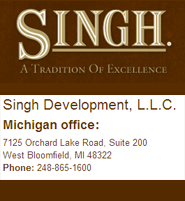|
|
|
|
|
|
Houston is the fourth-largest city in the United States of America and the largest city within the state of Texas. As of the 2006 U.S. Census estimate, the city has a population of 2.2 million within an area of 600 square miles (1,600 km²). Houston is the seat of Harris County and the economic center of the Houston–Sugar Land–Baytown metropolitan area—the sixth-largest metropolitan area in the U.S. with a population of around 5.6 million.
Houston was founded on August 30, 1836 by brothers Augustus Chapman Allen and John Kirby Allen
on land near the banks of Buffalo Bayou. The city was incorporated on June 5, 1837 and named after then-President of the Republic of Texas—former General Sam Houston—who had commanded at the Battle of San Jacinto, which took place 25 miles (40 km) east of where the city was established. The burgeoning port and railroad industry, combined with oil discovery in 1901, has induced continual surges in the city's population. In the mid-twentieth century, Houston became the home of the Texas Medical Center—the world's largest concentration of healthcare and research institutions—and NASA's Johnson Space Center, where Mission Control Center is located.
Houston's economy has a broad industrial base in the energy, manufacturing, aeronautics, transportation, and health care sectors; only New York City is home to more Fortune 500 headquarters. Commercially, Houston is ranked as a gamma world city, and the area is a leading center for building oilfield equipment. The Port of Houston ranks first in the United States in international waterborne tonnage handled and second in total cargo tonnage handled.
The city has a multicultural population with a large and growing international community. It is home to many cultural institutions and exhibits—attracting more than 7 million visitors a year to the Houston Museum District. Houston has an active visual and performing arts scene in the Theater District and is one of few U.S. cities that offer year-round resident companies in all major performing arts.
History
In August 1836, John Kirby Allen and Augustus Chapman Allen, two real estate entrepreneurs from New York City, purchased 6,642 acres (27 km²) of land along Buffalo Bayou with the intent of founding a city.
The Allen brothers decided to name the city after Sam Houston, the popular general of the Texans at the Battle of San Jacinto, who was elected President in September 1836.
Houston was granted incorporation on June 5, 1837, with James S. Holman becoming its first mayor.
In the same year, Houston became the county seat of Harrisburg County (now Harris County) and the temporary capital of the Republic of Texas.
In 1840, the community established a chamber of commerce in part to promote shipping and waterborne business at the newly created port on Buffalo Bayou.
By 1860, Houston had emerged as a commercial and railroad hub for the export of cotton. Railroad spurs from the Texas inland converged in Houston, where they met rail lines to the ports of Galveston and Beaumont. During the American Civil War, Houston served as a headquarters for General John Bankhead Magruder, who used the city as an organization point for the Battle of Galveston. After the Civil War, Houston businessmen initiated efforts to widen the city's extensive system of bayous so the city could accept more commerce between downtown and the nearby port of Galveston. By 1890 Houston was the railroad center of Texas.
Transaportation
Houston's freeway system is made up of 575.5 miles (926.2 km) of freeways and expressways in a ten-county metropolitan area. Its highway system uses a hub-and-spoke freeway structure serviced by multiple loops. The innermost loop is Interstate 610, which encircles downtown, the medical center, and many core neighborhoods with around a 10-mile (16 km) diameter. Beltway 8 and its freeway core, the Sam Houston Tollway, form the middle loop at a diameter of roughly 25 miles (40 km). A proposed highway project, State Highway 99 (The Grand Parkway), would form a third loop outside of Houston. Currently, the completed portion of State Highway 99 runs from just north of Interstate 10, west of Houston, to U.S. Highway 59 in Sugar Land, southwest of Houston, and was completed in 1994.
Houston also lies along the route of the proposed Interstate 69 NAFTA superhighway that would link Canada, the U.S. industrial Midwest, Texas, and Mexico. Other spoke freeways either planned or under construction include the Fort Bend Parkway, Hardy Toll Road, Crosby Freeway, and the future Alvin Freeway.
Houston's freeway system is monitored by Houston TranStar, a partnership of four government agencies that are responsible for providing transportation and emergency management services to the region. Houston TranStar was the first center in the nation to combine transportation and emergency management centers, and the first to bring four agencies (Texas Department of Transportation, Harris County, Texas, Metropolitan Transit Authority of Harris County, Texas and the City of Houston) together to share their resources.
The Metropolitan Transit Authority of Harris County, Texas, or METRO, provides public transportation in the form of buses, light rail, and lift vans. METRO's various forms of public transportation still do not connect many of the suburbs to the greater city.
METRO began light rail service on January 1, 2004 with the inaugural track ("Red Line") running about 8 miles (13 km) from the University of Houston–Downtown ("UHD"), which traverses through the Texas Medical Center and terminates at Reliant Park. METRO is currently in the design phase of a 10-year expansion plan that will add five more lines to the existing system.
Amtrak, the national rail passenger system, provides service to Houston via the Sunset Limited (Los Angeles–New Orleans), which stops at a train station on the north side of the downtown area. The station saw 10,855 boardings and alightings in fiscal year 2006.
Houston is served by two commercial airports, serving 52 million passengers in 2007. The larger is George Bush Intercontinental Airport (IAH), the ninth-busiest in the United States for total passengers, and seventeenth-busiest worldwide. Bush Intercontinental currently ranks third in the United States for non-stop domestic and international service with 182 destinations. In 2006, the United States Department of Transportation named George Bush Intercontinental Airport the fastest-growing of the top ten airports in the United States. Houston is the headquarters of Continental Airlines and Bush Intercontinental is Continental Airlines' largest hub. The airline offers more than 700 daily departures from Houston. In early 2007, Bush Intercontinental Airport was named a model "port of entry" for international travelers by U.S. Customs and Border Protection. The Houston Air Route Traffic Control Center stands on the George Bush Intercontinental Airport grounds.
|
|
|




|
|
|
|
|